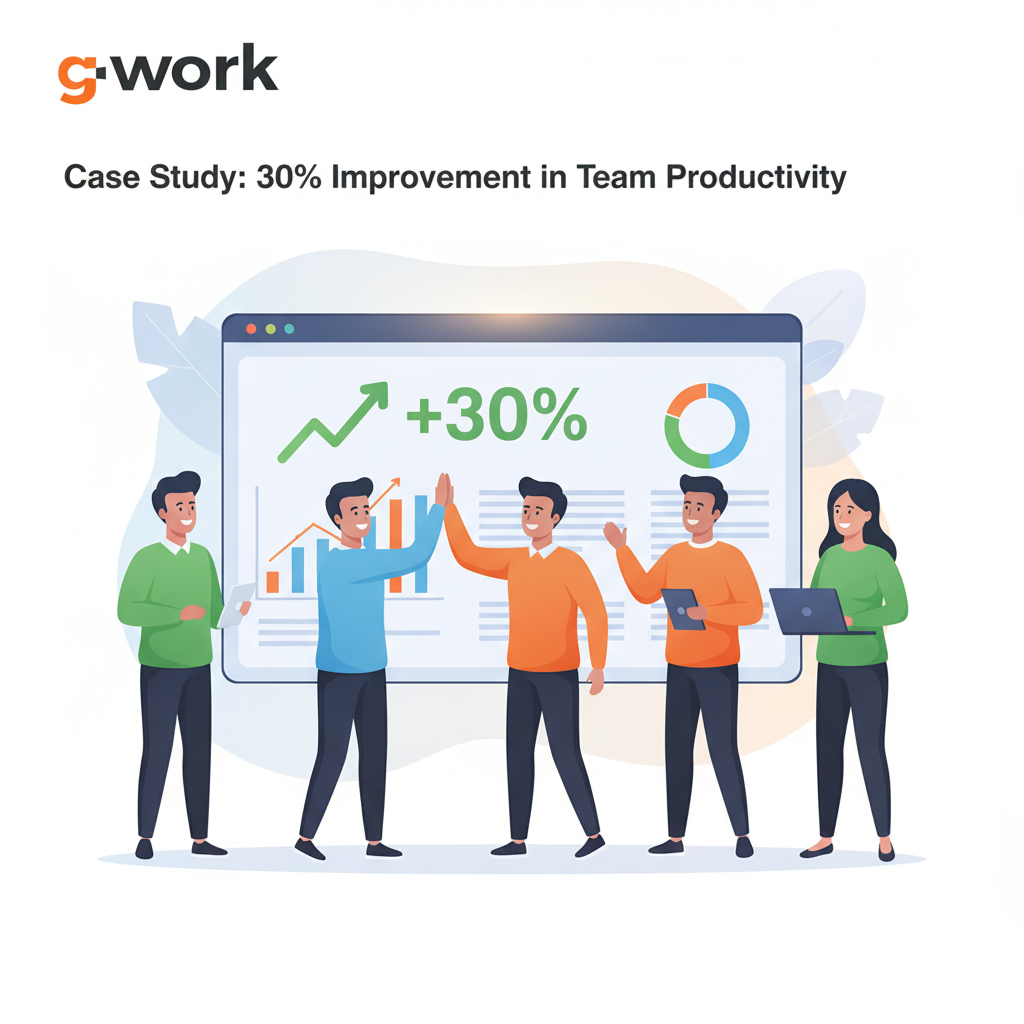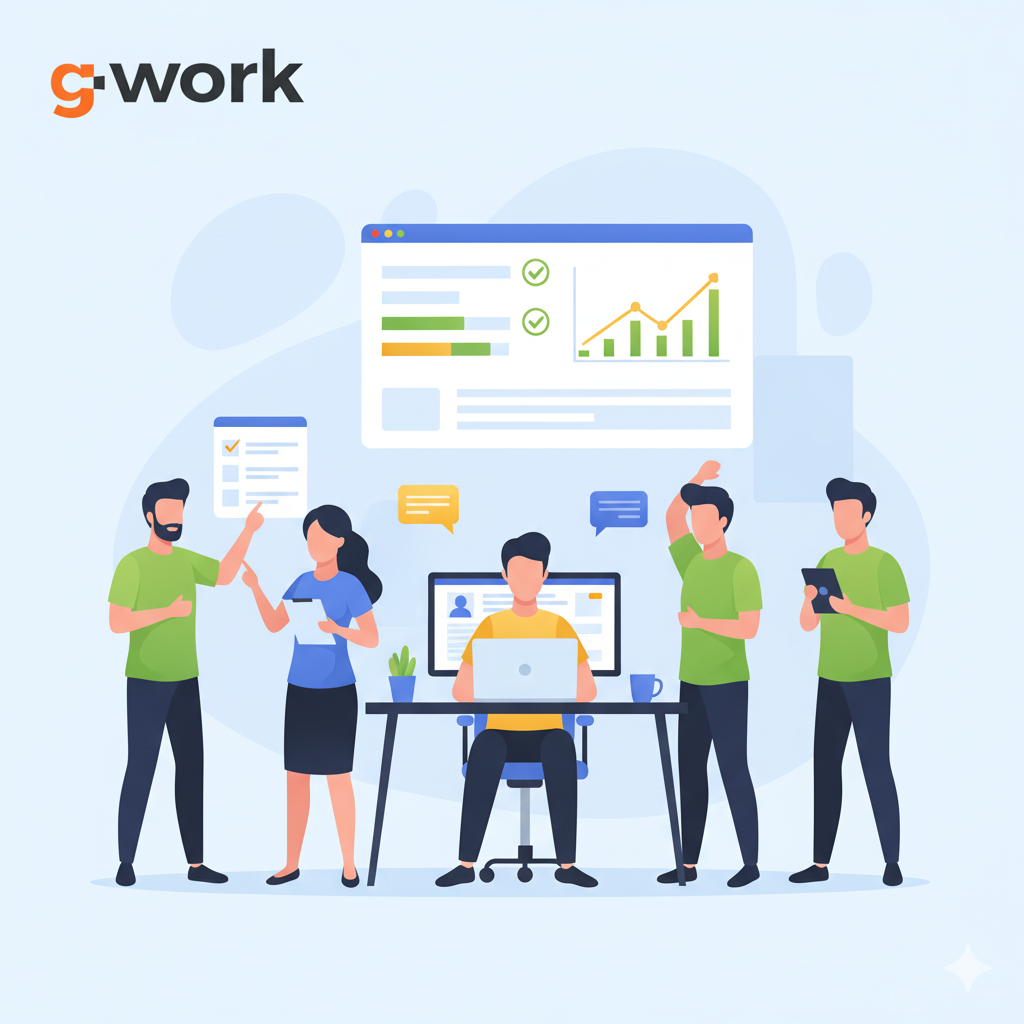In the modern competitive world of work, high team productivity is a fundamental requirement by any organization. Teams are subject to the pressure of meeting the deadlines, producing high-quality work, and having to be consistent in performance. However, the problems of productivity, like ineffective working processes, distorted roles, and unmeasurable objectives tend to drag the teams down.
The case study presented in this blog is interesting as it indicates a 30% improvement in team productivity. You will be taught the tactics, tools, and habits that have lead to this success. We are also going to dive into the features of platforms such as GWork that enable teams to follow performance, automate processes and integrate habits that enhance efficiency.
This guide has useful ideas whether you are a manager who wants to get practical tips or you are a team member who wants to manage your workflow optimally. By the end, you’ll have a roadmap to improve team productivity sustainably.
Understanding Team Productivity
It is important to comprehend the meaning of team productivity before you get into the case study. In simple terms, team productivity refers to the capability of a group to perform efficiently, realize objectives, as well as to produce high quality output on a regular basis. It is not the number of hours one works but it is about working smarter, making the correct decisions, and utilizing the right tools to accomplish things. The direct consequences of team productivity are business outcome, employee engagement and satisfaction at the workplace.
Why Measuring Team Productivity Matters
Productivity is an important measure that any organization wishing to grow and succeed must measure. It is almost impossible to recognize gaps, streamline processes or promote accountability without monitoring performance. This is why the importance of team productivity measurements is so big:
- Discover Weaknesses: Map of productivity helps to see bottlenecks, inefficiency, and possible underperforming teams.
- Establish Specific Ambitions: Teams are better able to focus on tasks and work towards goals when they know specific goals that they are supposed to achieve.
- Promote Responsibility: Open performance measures encourage employees who are eager to get involved and claim ownership of their job.
- Achieve Better Employee Performance: Once employees can visualize how their behaviours influence outcomes, they will tend to establish productive behaviours and stay highly productive.
Common Productivity Challenges
Even the most experienced teams experience issues that make the teams less productive. The initial step that must be taken in dealing with these obstacles is recognizing them. Some common issues include:
- Lack of Roles: In the absence of clear roles, the team members can end up repeating their work or failing to carry out important responsibilities.
- Ineffective Communication: The lack of understanding, time wastage and communication lapses may impede progress and cause errors.
- Unproductive Task Monitoring: Lack of effective tracking mechanisms can lead to missed deadlines, loss of priorities and lack of accountability.
- Opposition to Habits: Workers can have a hard time adopting regular productivity patterns, including scheduling daily activities or time-blocked work shifts.
- Absence of Tools: Teams that are deprived of efficient team productivity tools are likely to struggle to coordinate workflows, monitor progress, and work as a team.
To overcome these obstacles, it will be necessary to combine the practice of habits, tracking of performance, and the application of contemporary team productivity tools. Teams can eliminate these obstacles by building systematic procedures, motivating positive practices, and adopting tools, which deliver feedback in real-time, to help them become much more efficient, improve quality of output, and engage employees.
By concentrating on these aspects, it is possible to not only improve productivity but also improve the workplace, assist a team in embracing improved work practices, and secure success in the long term.
The Case Study Overview
The case study is about a middle technology company that was experiencing a severe deterioration in team productivity. The team also had a problem of missed deadlines, poor output quality, and lack of motivation among employees which influenced the overall performance of the business. Managers observed that work was usually reworked, projects were not completed in time and employees were experiencing burnout as evidenced by decreased motivation and loss of energy at work.
Initial Productivity Metrics
To know the baseline, the performance of the team was measured before any interventions:
- Project Completion Rate: Project Completion was done on time only on 68% of projects, which led to delays to clients and internal stakeholders.
- Task Efficiency: Only 60% of the tasks were performed error-free and without rework, which shows inefficiency of both workflow and quality control.
- Employee Engagement: The engagement levels were average, and some team members were tired, were lowly motivated, and exhibited signs of stress.
Recognizing the urgent need for improvement, the company set an ambitious goal: to increase team productivity by 30% within six months using structured strategies, habits, and productivity tools.
Strategies Implemented to Improve Team Productivity
To do this, the company put emphasis on three areas, which include, habit adoption, performance tracking, and productivity tools.
1. Habit Adoption for Team Productivity
Habits drive consistency. The team adopted micro-habits to enhance productivity without overwhelming employees. These included:
- Daily Planning: On a daily basis, employees used 10 minutes at the beginning of the day to prioritize.
- Time Blocking: Special work sessions were planned minimising distraction.
- Short Daily Check-ins: Rapid meetings were used to provide alignment and deal with possible blockers.
- Reflective Reviews: Employees were able to assess their performance and what needed improvement; this was done through end of day reviews.
These habits allowed the team to save time, become more focused, and more productive.
Example: A developer was practicing time-blocking by trying to spend two hours every morning in coding without distractions. In the past, meetings and messages were frequent, hence interfering with concentration and thus resulting in half-finished work. Once this habit was adopted, the level of work completion was increased by 25% in a month.
2. Leveraging Team Productivity Tools
The company implemented team productivity tools to track performance and streamline workflows. The chosen tools included:
- Task Management Platforms: For assigning tasks, tracking deadlines, and monitoring progress.
- Analytics Dashboards: To identify trends in performance and engagement.
- Automated Reminders: Ensured team members stayed aware of priorities and deadlines.
With these tools, the team would be able to quantify the productivity of the team and take proactive measures to enhance efficiency.
Example: The project manager observed through the use of a task management tool that 15% of the tasks were always delayed. The team decreased the delays by 40% by redistributing the resources and organizing priorities more clearly.
3. Encouraging Collaboration and Communication
Improved collaboration was essential. Strategies included:
- Unified my channels of communication: Less random emails and greater visibility.
- Shared Workspaces: This was where one or more team members were given the option of working on documents concurrently.
- Frequent Feedback Sessions: Constructive feedback was regularly given to employees by managers, which helped employees to continuously get better.
The increased cooperation minimized misunderstandings and time was saved as well as productivity was enhanced.
Case Study: Feedback sessions on weekly basis assisted a design unit in early detection of frequent errors. This anticipatory strategy decreased the rework and increased the quality of output by 20%.
Results Achieved
Six months after implementing these strategies, the company achieved remarkable improvements.
Productivity Metrics Post-Implementation
- Project completion rate: Increased to 88% on time
- Task efficiency: Improved to 85% of tasks completed without rework
- Employee engagement: Significantly improved, with employees reporting higher satisfaction and reduced stress
These improvements equated to a 30% increase in team productivity.
Additional Benefits
- Reduced burnout and work-related stress
- Greater motivation to adopt productive habits
- Improved collaboration and communication
- Higher quality output with fewer errors
This case study proves that consistent strategies, combined with habit adoption and the right team productivity tools, can dramatically improve results.
How GWork Helps Boost Team Productivity
One of the elements that contributed to the 30% productivity increase of the team was the implementation of GWork, which is a platform that is specifically created to simplify workflows, improve performance, and facilitate the adoption of habits. GWork assisted the company in solving the main issues of the company such as lack of proper time constraint, poor tracking of tasks and inconsistent employee involvement. GWork offered the team a centralized platform giving them a chance to concentrate on what is important, quality results to be delivered in an effective way.

GWork Features Driving Productivity
1. Task Management:
GWork enables managers to delegate responsibilities, establish deadlines and track real-time progress. This will bring about clarity in the duties, elimination of duplication of tasks, and assist the employees to remain on track.
2. Performance Analytics:
When equipped with in-built analytics, managers are able to monitor employee performance, establish where the bottlenecks are and make wise decisions within a short period. Empirical evidence can be used to make proactive changes in order to enhance team performance.
3. Habit Tracking:
GWork motivates the employees to develop good habits, including day-to-day planning and time blocking. The platform reminds and monitors the progress and assists employees in being consistent and enhancing output.
4. Collaboration Tools:
Reduced errors, better coordination, and simplified workflow are centralized communication features. Updates, feedback and documentation can be shared among the teams in a single location keeping all the team members in check.
5. Reporting Dashboards:
Dashboard in real time gives a holistic overview of team performance. Team productivity can be easily measured and tracked by the managers, progress against goal can be monitored and improvement areas can be identified.
Through these features, the team was in a position to streamline priorities, keep accountability and attain sustained productivity upgrades. GWork multi-purpose task management, analytics, and habit-tracking solution turned out to be a crucial factor in delivering quantifiable outcomes.
[Try GWork for 360 Feedback → Get Your Free Habit Blueprint]
Lessons Learned from the Case Study
This experience yielded a number of important lessons:
- Minuscule Behaviors Build up to Macro victories: Micro-habits such as planning everyday and time blocks are the behaviors that result in measurable outcomes.
- Tools are also important: GWork helps to track, monitor and enhance team performance using platforms.
- Communication Leads to Success: Efficiency and reduction of errors is achieved through clear and consistent communication.
- Ongoing Measurement: Speaks Volumes: The frequent monitoring of the teams is needed to keep them on Twitter and to endure the problems in advance.
- Employee Engagement Increases Productivity: Satisfied employees who are motivated give more results.
These lessons can help other teams replicate similar successes and improve team productivity sustainably.
Actionable Tips to Increase Team Productivity
The following are some of the steps that teams can undertake in order to enhance productivity:
1. Set Clear Goals
Establish team goals which are specific and measurable. Track progress with such tools as GWork.
2. Adopt Daily Planning
Challenge team members to schedule their day, to make priorities and to establish realistic goals.
3. Use Productivity Tools
Adopt systems that trace activities, assess the progress and give practical feedbacks. GWork is a very good example.
4. Introduce Time Management measures
These methods are time-blocking, Pomodoro, and reducing distractions to improve focus and productivity.
5. Foster Collaboration
Promote free flow, frequent feedback and common workflows.
6. Observation of Performance Measures
Periodically evaluate productivity on both qualitative and quantitative measures.
7. Recognize Achievements
Reward personal and team victories to encourage employees and encourage productive behaviors.
8. Address Pitfalls Early
Detect bottlenecks, lack of clear responsibility and gaps in the workflow in the early stages to avert a long term problem on productivity.
Measuring and Tracking Team Productivity
Accurately measuring productivity is essential for long-term success.
- Quantitative Metrics: Track task completion rates, deadlines met, and output quality.
- Qualitative Metrics: Assess collaboration, communication, and employee engagement.
- Employee Feedback: Use surveys and check-ins to identify areas for improvement.
- Analytics Tools: Platforms like GWork provide real-time dashboards and insights to track team productivity effectively.
These methods allow teams to make data-driven decisions and continuously enhance performance.
Long-Term Strategies for Sustained Productivity
Achieving a one-time improvement is not enough. Teams need strategies for maintaining high productivity over time:
- Regular Skill Development: Provide training to enhance employee capabilities.
- Continuous Process Improvement: Review workflows regularly and implement enhancements.
- Habit Reinforcement: Encourage the consistent practice of productive habits.
- Ongoing Use of Productivity Tools: Platforms like GWork ensure that teams continue tracking performance and improving efficiency.
- Employee Recognition Programs: Reward and recognize consistent high performance.
Conclusion
This case study demonstrates that structured strategies can lead to a 30% increase in team productivity. By adopting habits, leveraging productivity tools, and improving collaboration, teams can achieve remarkable results.
GWork is vital as it assists teams to measure, monitor, and optimize productivity to guarantee the success of workplaces and employee performance.
As a manager or a team member, these points demonstrate that it is possible to achieve productivity enhancement through the development of appropriate strategies and tools. Begin applying them today in order to achieve tangible gains in productivity, quality and workplace satisfaction.
Book a Demo or Get Your Free Habit Blueprint with GWork today.
FAQs: Team Productivity and How GWork Helps
1. What should I do to be able to measure team productivity?
The productivity can only be measured through both quantitative and qualitative measures. Quantitative parameters are the rates of task completion, performance of tasks according to deadlines and the quality of output. Qualitative measures are concerned with teamwork, interaction, and productivity. Technologies such as GWork offer real-time dashboards and analytics, which facilitates performance monitoring to create ways to improve them.
2. Which are the most effective team productivity tools?
There are various tools that assist the teams to organize work and enhance productivity. The most popular are GWork, Asana, Trello, Monday.com, and Jira. Such platforms enable allocation of tasks, tracking of progress and teamwork and are also insightful to enable managers to make informed decisions.
3. What is the way in which adoption of habits can enhance the success of employee performance?
By consistently applying micro-habits, e.g. planning every day, time-blocking, reviewing and reflecting on past performance, it is possible to improve focus and efficiency and improve the quality of output. Adoption of habit motivates the employees to work smarter, consistent, and to minimize errors in their daily work.
4. What is the contribution that GWork makes towards team productivity?
GWork is a tool integrating the task manager with performance tracking, and habit adoption. It enables teams to delegate activities, track the progress, promote positive productive behavior, and produce actionable analytics, which, in turn, leads to a quantifiable productivity increase.
5. What do I do to maintain team productivity benefits in the long-term?
Success cannot be achieved in the long term without a constant effort. The teams are to be concerned with skill development, constant improvement of processes, reinforcement of productive habits, and frequent use of productivity tools. This is aided by such platforms as GWork, which offer tracking, reminders, and analytics to ensure high performance.
6. Which are the typical issues in team productivity?
Some of the problems that teams experience include a lack of clarity in their roles, ineffective communication, lack of effective task tracking, habit resistance, and inadequate tools. Early recognition of these obstacles will enable managers to put in place measures to enhance the workflow and performance.
7. What can managers do to stimulate team productivity?
Managers are able to establish clear objectives, give feedback regularly, promote teamwork, celebrate success and establish task management tools. The maintenance of high productivity is also achieved by encouraging the use of habits and analytics to track the progress.
8. Is it true that productivity can be difference when it comes to small differences?
Yes. Even the slightest transformation such as scheduling daily activities, time-blocking methods, or the adoption of a new team-working tool can boost efficiency greatly. These minor transformations continue to add up over time and result in observable positive productivity in the team.










